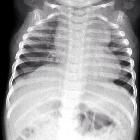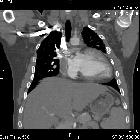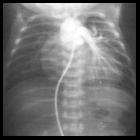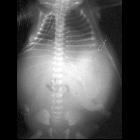Zyanotischer Herzfehler

Cyanotic
congenital heart disease • Total anomalous pulmonary venous return (TAPVR) - Ganzer Fall bei Radiopaedia
A number of entities can present as cyanotic congenital heart disease. These can be divided into those with increased (pulmonary plethora) or decreased pulmonary vascularity :
- increased pulmonary vascularity
- total anomalous pulmonary venous return (TAPVR) (types I and II)
- transposition of the great arteries (TGA)
- truncus arteriosus (types I, II, and III)
- large AVSD
- single ventricle without pulmonary stenosis
- decreased pulmonary vascularity
- tetralogy of Fallot
- hypoplastic right heart syndrome: pulmonary vascularity dependent on systemic collaterals
- tricuspid atresia
- hypoplastic right ventricle
- pulmonary atresia or severe stenosis
- Ebstein anomaly with atrial septal defect
- many other combined and infrequent anomalies such as
- double outlet right ventricle (DORV) with pulmonary stenosis
- single ventricle with pulmonary stenosis
- Uhl anomaly
- pentalogy of Cantrell
The most important cyanotic congenital heart defects can be remembered with the five Ts mnemonic.
Siehe auch:
- Atriumseptumdefekt
- Herzfehler
- Ebstein anomaly
- acyanotic congenital heart disease
- Fallot'sche Tetralogie
- Transposition der großen Arterien
- tricuspid atresia
- hypoplastic left heart syndrome
- double outlet right ventricle (DORV)
- atrioventricular septal defect (AVSD)
- totale Lungenvenenfehlmündung
- Normale Herzkonfiguration im Röntgen-Thorax
- congenital heart disease - chest x-ray approach
- Cantrell’sche Pentalogie
- Nicht-zyanotische Herzfehler
- Truncus arteriosus communis
und weiter:

 Assoziationen und Differentialdiagnosen zu Zyanotischer Herzfehler:
Assoziationen und Differentialdiagnosen zu Zyanotischer Herzfehler:atrioventricular
septal defect (AVSD)














